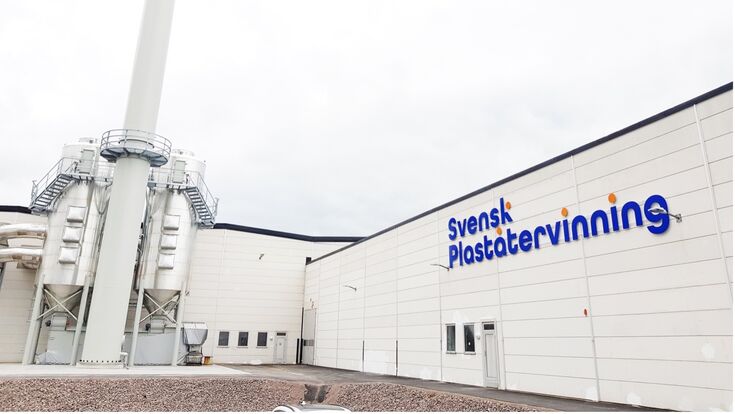Recycling : Site Zero: How a Swedish plastic sorting plant is changing plastic recycling.

The world’s biggest plastics sorting plant in Motala, Sweden
- © Svensk PlaståtervinningCompared to the previous facility, which was already one of the most efficient in Europe, Site Zero in Motala, Sweden, is doubling the amount of plastic it recycles: Billed as the largest of its kind, it’s capable of sorting up to 200,000 tons of plastic packaging a year. But it's not just the size, but the cutting-edge technology that makes this feat possible. Infra-red cameras are used to separate the flood of waste that arrives at the factory gates into 12 different types of plastic. Up to 95 percent of all packaging received will be able to be recycled. “The conditions now exist to actually make plastics part of the circular economy,” says Mattias Philipsson, CEO of Svensk Plaståtervinning. The old plant on the same site could only sort five types of plastic, which meant that only 47 per cent of the material was recycled and the remaining was incinerated.
>>> Site Zero: this is the world's largest plastic sorting plant
At Site Zero, as conveyor belts carry 40 tons of mixed plastic waste through the bowels of the factory every hour, the roar of the machines is deafening. In a fully automated process that relies on infrared cameras, the chocolate wrappers, plastic bags, yoghurt pots and white polystyrene are gradually broken down, separated by size, and sorted as they make their way through the 60,000 square meter complex.
It is no longer justifiable to incinerate as much plastic as we do or melt it down into low-quality products that cannot be recycled again.Mattias Philipsson
The plant has been tested for some time before it opened in November 15, and the results show record sorting efficiency. Up to 95 percent of the packaging that arrives at the plant can be sorted out for recycling in the next step. “This means a doubling of plastic recycling compared to our previous plant, which was already one of the most efficient in Europe. The results from the test period show that plastic can now become part of the circular economy,” states Mattias Philipsson, CEO of Svensk Plaståtervinning.
>>> Sirmax collaborates with design brand Arper to create a collection of sustainable chairs
Philipsson continues: “With Site Zero, we have set a new path for plastic recycling and the rest of Europe. The world needs to follow, to reduce emissions from incineration and the need for primary raw materials. It is no longer justifiable to incinerate as much plastic as we do or melt it down into low-quality products that cannot be recycled again,” says Mattias Philipsson.
Site Zero is able to process 200,000 tons of plastic packaging, making it the largest sorting facility in the world. This is roughly equivalent to the total amount of plastic packaging placed on the market in Sweden. Approximately half of this plastic packaging is collected by the Swedes, and until more plastic finds its way into the recycling system, Svensk Plaståtervinning has offered its capacity to other countries. From 2024 onwards, Site Zero will receive the majority of the household plastics in Finland.
Big Opening Party
Over 300 representatives from the plastics value chain were invited for the grand opening on 15 November, hearing various presentations and watching live demonstrations. In a press conference, Mattias Philipsson, Michael Ludden, CEO of Sutco and Yannick Rödder, Project Manager of Sutco, shared their perspectives and their vision for the future of the project. They emphasized that the plant will be the first of its kind. It will be able to produce the highest quality material while reducing its environmental footprint.
>>> What is recycling in the 21st century?
“We are excited to have such strong and knowledgeable partners by our side. The collaboration in our first project has already convinced us of TOMRA and Sutco. It is the quality and flexibility their systems offer and the reliable service that made them our partners of choice. Together we aim to make Site Zero a blueprint for sorting facilities in Europe”, explains Philipsson in front of the audience.
“It’s a game changer,” said Åsa Stenmarck, member of the Swedish Environment Protection Agency. “Not just the sorting itself, but that they actually believe there is finally a market” for all 12 types of plastic sorted by the plant.
By 2060 global plastic waste will triple
The world is currently producing more than 430 million tons of plastic a year, two thirds of which are short-lived products that will soon become waste and fill up the oceans. And they often find their way into the human food chain, according to a recent report by the UN Environment Programme. And the amount of plastic waste produced globally is set to triple by 2060, with around half going to landfill and less than a fifth being recycled.
>>> TOMRA and Plastretur plan first plant for plastic packaging sorting in Norway
Once separated, plastic can be recycled by traditional mechanical recycling or by chemical recycling, which usually uses heat or chemical solvents to decompose plastic into liquid and gas, producing a mixture similar to oil or basic chemicals. This mixture can be turned back into plastic pellets to make new products, according to industry leaders. But environmental groups say chemical or advanced recycling is distracting from real solutions like making and using less plastic. Philipsson said that the more efficient sorting plant in Motala will help to increase the amount of plastic that is recycled in Sweden, it will also depend on households separating their waste in the right way. “Most plastics are still incinerated because they haven’t been sorted by households,” he said.



